1. Biosphere and its Components
Chapter 14
Natural Resources
Introduction
Life on Earth is possible because of the presence of these three major sources. A zone where the lithosphere, the atmosphere and the hydrosphere intersect and the life sustains is called the Biosphere.
The biosphere can be divided into two parts:
The biosphere can be divided into two parts:
• Abiotic Components – The non-living things such as air, water and land
• Biotic Components – The living things such as plants and animals
Resource – A Resource is a stock or supply of something useful. Resources can be manmade or Natural.
Natural Resources – A Resource which exists in nature is called a Natural Resource. It is not produced by any human being; rather it is available in nature itself. Human beings and other animals depend upon these resources for their existence.
Natural Resources present on Earth:
• Air – The atmosphere which contains different gases such as Oxygen, Nitrogen and carbon dioxide which are required for the survival of life on earth.
• Water – The hydrosphere which covers almost 75% of the Earth surface. It is a home to an abundance of animals and plants and is also required for the survival of life on earth.
• Land – The upper crust of the earth is called Lithosphere where different kinds of soils are found which are necessary for the growth of plants and are a home to several vitamins and minerals.
2. Types of Pollution
Pollution: Contamination of natural sources with unwanted substances.
Air Pollution
The presence of harmful substances in the air leads to pollution of the air. It can severely affect the health of living organisms and the quality of the environment.
What causes Air Pollution?
• Burning of Fossil Fuels – When coal and petroleum are burnt, they release sulphur and nitrogen oxides which are harmful agents. They also release unburnt carbon particles in the air called Hydrocarbons.
• Exhaust from Industries – The industries release harmful gases and smoke in the air that contains carbon monoxide and organic compounds that decrease the quality of the air.
• Mining – During the mining process harmful chemicals are released in the air that leads to air pollution.
• Indoor Activities – Cleaning agents and paints used in houses release harmful chemicals which pollutes the air
• Suspended Particulate Matter – The particles such as dust often remain suspended in the air and degrade its quality. SPM is one of the major causes of air pollution in the cities.
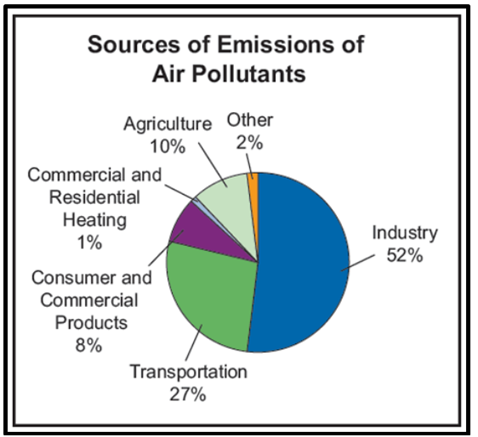
What are the effects of Air Pollution?
• Acid Rains – Rains often contain acidic compounds that can affect animals, plants and crops.
• Harmful diseases and allergies – Inhalation of harmful substances can lead to diseases such as heart problems and cancer and allergic reactions in the skin and eyes.
• A decrease in the visibility – The suspended particles in the air affects the visibility and also lead to the formation of smog in the cold weather.
• Global Warming – The temperature of the earth rises due to the presence of greenhouse gases in it such as carbon dioxide and methane.
• Ozone Layer Depletion - The air pollution leads to depletion of the outer covering of the ozone layer around the earth’s atmosphere.
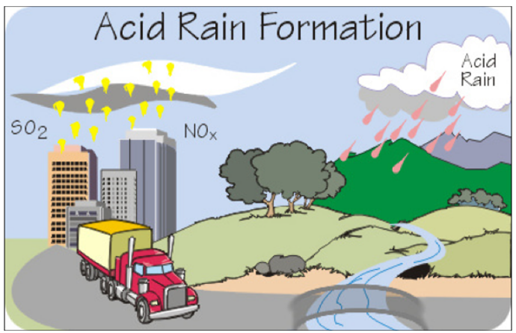
Water
The different forms of water present on the earth are:
• Water Vapour – found in the atmosphere
• Saline Water – found in seas and oceans
• Freshwater – found in frozen ice caps, snow-covered mountains, underground, rivers, lakes and ponds
Why Water is necessary for Life?
• The presence of water in a region decides the biodiversity of that area to a great extent.
• The cellular processes take place in the water-like-medium.
• A major constituent of blood is water which allows it to carry substances throughout the body.
• Water helps in regulating the body temperature in animals and human beings.
• It prevents the tissues, organs and cells from drying out by keeping them moist.
• Water helps in digestion of food.
• Water helps in the removal of waste products out of the cells.
• Plants also require water to transport food through different parts such as the stem and leaves and also in the process of photosynthesis.
Water Pollution
Water pollution occurs when harmful substances such as chemicals and waste materials like garbage are present in water that affect its quality and the presence of life in it.
Causes of Water Pollution
• Waste from Industries – The industries often release chemicals directly into water bodies such as rivers and seas which contaminates it.
• Sewage – The waste produced from households is often released into the water which gives rise to harmful bacteria in the water.
• Mining Activities – The metal wastes obtained from mining activities harm the organisms present in water
• Usage of Fertilizers and Pesticides – The chemicals present in fertilizers and pesticides are extremely harmful to aquatic animals, plants as well as animal consumption.
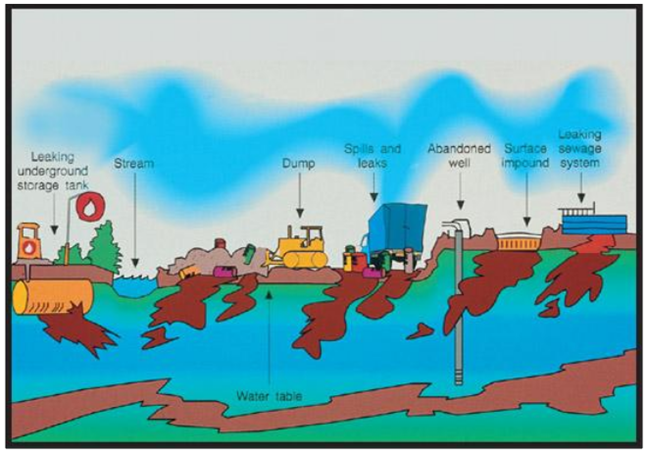
Effects of Water Pollution
• Addition of unwanted substances such as fertilizers pesticides and industrial wastes can make it poisonous and extremely harmful for consumption.
• It can also lead to an increase in bacteria that causes severe diseases like Cholera.
• Water pollution can lead to a decrease in the amount of Oxygen and nutrients in the water which affects the aquatic life.
• Water pollution can cause changes in the temperature of water. An increase in temperature is not suitable for all the aquatic animals especially their eggs.
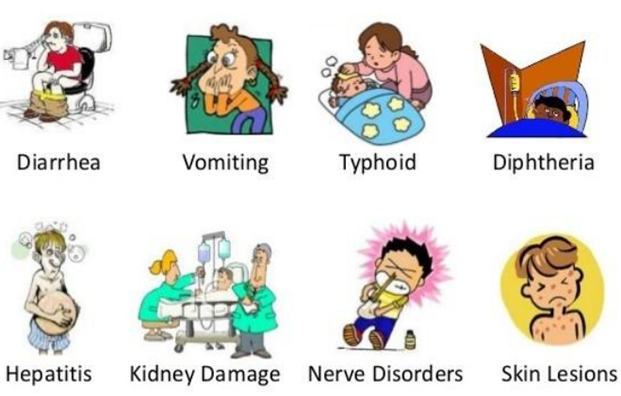
Ozone Layer Depletion
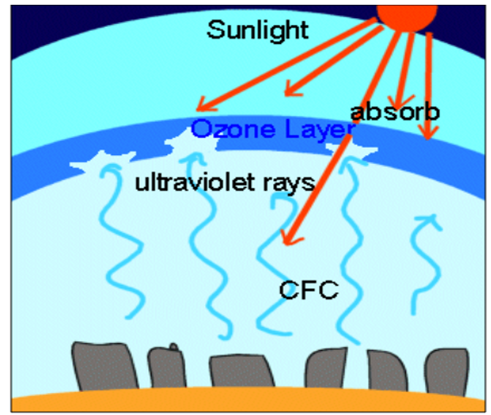
It has been discovered that the Ozone Layer is getting depleted from the earth's atmosphere. A hole in Ozone Layer has been found over Antarctica.
• This is mainly because of the presence of the Chlorofluorocarbons (CFCs) in the atmosphere. These are released due to industrial processes, refrigeration, aerosols, foams and solvents.
• The chlorine and fluorine present in these on reaching the Ozone Layer react with it to form complex compounds and it thus results in depletion of Ozone.
- If the Ozone Layer would deplete the ultraviolet rays of the sun would under the Earth’s atmosphere which could lead to severe effects such as:
• An increase in the risk of having skin cancer
• Damaging the eyes
• The weakening of the immune systems
• Skin allergies
• Decay in the growth of plants and animals
• Breakdown of the natural carbon cycle
Water harvesting
• Water harvesting is the collection of run off for productive purposes.
• Instead of run off being left to cause erosion, it is harvested and utilized.
• In the semi-arid drought-prone areas where it is already practiced, water harvesting is a directly productive form of soil and water conservation.
Eutrophication
• Eutrophication is the process in which a water body becomes overly enriched with nutrients, leading to plentiful growth of simple plant life.
• The excessive growth (or bloom) of algae and plankton in a water body are indicators of this process.
• Eutrophication is considered to be a serious environmental concern since it often results in the deterioration of water quality and the depletion of dissolved oxygen in water bodies.
• Eutrophic waters can eventually become “dead zones” that are incapable of supporting life.
Biological Magnification
Biomagnification can be defined as the rise or increase in the contaminated substances caused by the intoxicating environment. The contaminants might be heavy metals such as mercury, arsenic, and pesticides such as polychlorinated biphenyls and DDT.
Causes of biomagnification.
- Agriculture
The agricultural pesticides, insecticides, fertilizers and fungicides are very toxic and are released into the soil, rivers, lakes, and seas. These substances contain small amounts of heavy metals such as mercury, arsenic, copper, lead and cadmium. These cause health issues in aquatic organisms and humans.
- Organic Contaminants
Manures and biosolids are processed industrially and contain contaminants like pharmaceuticals and personal care products. These substances have an adverse impact on the health of humans, animals, and wildlife.
- Industrial Activities
The industries and factories release toxic substances that are released into the soil, lakes, oceans, and rivers. The gaseous emissions pollute the environment which enters into the food chain leading to biomagnification.
Effects of biomagnification on living organisms and the environment:
- Impact on Human Health
Biomagnification makes humans more prone to cancer, kidney problems, liver failure, birth defects, respiratory disorders, and heart diseases.
- Destruction of Coral reefs
Cyanide that is used in leaching gold and fishing is the main cause of the destruction of coral reefs. Coral reefs are the dwelling and feeding grounds for many sea creatures. Their destruction affects the lives of many aquatic animals.
- Disruption of Food Chain
The chemicals and toxins which are released into the water bodies disrupt the food chain. The small organisms absorb the toxins which are eaten up by larger animals. These toxins, thus, get accumulated in the higher level of organisms.
3. Soil
SOIL
It is a mixture. It is the portion of earth surface consisting of various components like small particles of rock (of different sizes, bits of decayed living organisms which are called humus, various forms of microscopic life, air and water.
Soil Profile
• The soil is found in several layers which are arranged as the soil is formed.
• The layers of the soil are also called as Horizons.
• These layers have different types of soil particles and colour and hands are differentiated on this basis.
• The soil profile is defined as the vertical section of soil that represents the sequence of layers to the soil.
• The layers of the soils help in understanding the usage of that soil.
• The soil mainly consists of four layers. Such a soil is called Mature Soil.
• Some types of soils consist of two layers only. They are called Immature Soils.
The Layers or Horizon of Soil
1. The Topsoil or Horizon A or the Humus Layer
• This layer of soil consists of organic matter and decomposed substances.
• It is dark in colour, porous and can hold air and water in good amounts.
• Due to such quality, many living organisms are found in the topsoil, for example, the earthworms, fungi and bacteria.
Horizon O
Some soils contain a layer of organic matter which consists of a large number of decomposed leaves and humus. It is called the organic layer of the soil.
2. Subsoil or Horizon B
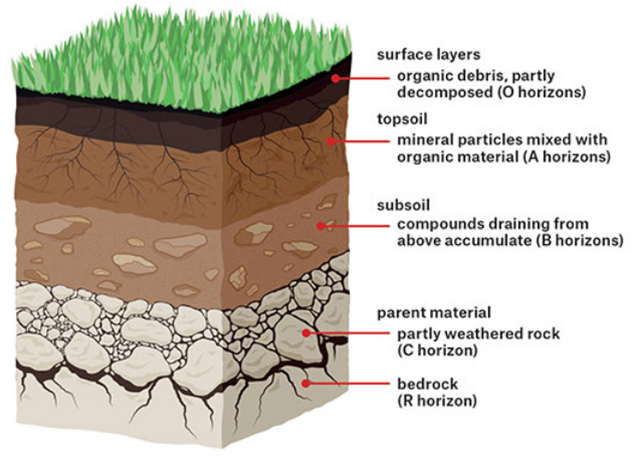
• It lies below the topsoil. It is hard and compact than the topsoil.
• The subsoil has a light colour because it does not contain much humus.
• The subsoil does not contain much organic matter other but contains minerals in good quantity and metal salts like iron oxide.
• When farmers plough their field, they often mix the topsoil and subsoil so that the crops can grow easily.
3. Horizon C or Regolith
This layer lies beneath the subsoil layer.
It is very hard and consists of stones and partly weather pieces of rocks. There is no organic matter in this layer. The roots of plants and trees cannot penetrate up to this layer.
4. Horizon R or Bedrock
This is the last layer of the soil which consists of un weathered rocks
Factors affecting the formation of Soil
- The Sun -
• It is responsible for breaking down the rocks into smaller pieces and forming cracks in between them.
• The sun's radiations heat up the rocks during the daytime. As a result, the rocks expand.
• But during the night, these rocks cool down and therefore contract.
• All the parts of the rocks may not cool down or heat up at the same time.
• All this leads to the formation of cracks in them and ultimately breaks them down.
2. Water –
• Water gets into the cracks of the rocks and freezes down there.
• This leads to whitening of the cracks.
• Flowing water often carries pieces of rocks away and on that path, they get broken down into smaller pieces as they rub against each other and also due to the pressure of the flowing water. This is one of the reasons why soil is formed far away from the parent Rock.
3. Winds –
• Winds can wear down the rocks and break them.
• Strong winds rub against the rocks and break them or wear them down just like water.
• Winds also carry away the soil or sand from one place to another.
4. Living organisms –
• Lichens that can grow on the rocks and secrete a certain substance that can powder down a rock which leads to the formation of soil.
• Small plants such as moss often grow on rocks and break them down.
• It may also happen that the roots of different plants and trees get into the rock’s surface and break it down or widen the cracks.
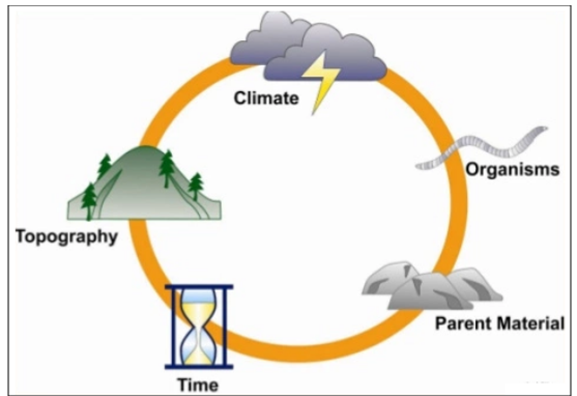
Soil is a mixture of various substances It contains the following:
• Small pieces of rocks
• Bits of decayed living organisms called the Humus
• Microscopic organisms
• Minerals and nutrients
Factors that decide the type of soil
• The amount of humus present in the soil – the more the humus the more porous and deep the soil is.
• The number of microscopic organisms in the soil – they help in keeping it fertile
• The parent rocks – they decide the minerals that are present in the soil
Soil Pollution
We know that soil contains different types of substances all of them are responsible for the sustenance of the biodiversity. When the useful components get removed from the soil, it loses its fertility and leads to a decrease in the microscopic life in it. This phenomenon is called soil pollution.
The Causes of Soil Pollution
• Long usage of fertilizers and pesticides leads to the killing of the microorganisms present in it. Without these organisms, the soil would not get recycled and replenished. Earthworms get killed because of the pesticides. They are the ones that lead to the formation of humus in the soil.
• Flowing water and winds can carry away the soil particles and often lead to exposure of rocks.
• Deforestation can also lead to soil pollution as the uprooting of trees exposes the soil to rains and winds.
• Industrial activities like mining and extraction of minerals can lead to a mixture of harmful chemicals in the soil and decay its quality.
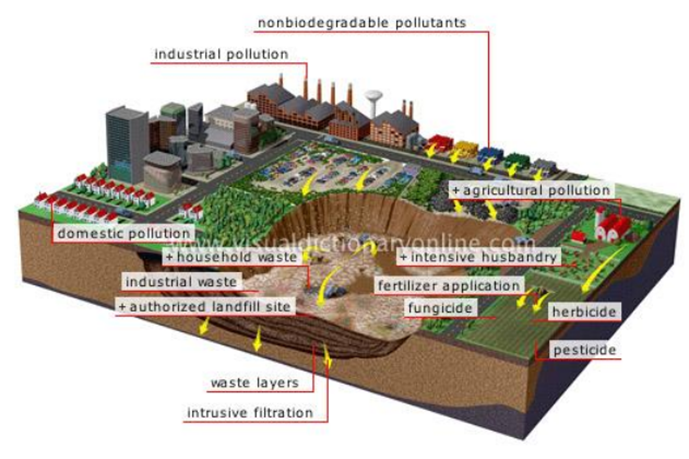
Effects of Soil Pollution
• It severely affects the growth of plants.
• It can lead to infertility of soil and thus would restrict agriculture on such land.
• The fertilizers decay the quality of the soil.
• It can affect the health of human beings who consume food grown in soil which has large amounts of fertilizers and pesticides mixed in it.
• It can change the structure of soil thus decaying the growth of useful bacteria and other microorganisms in the soil.
Soil Erosion – It a process in which the upper layer of the soil gets washed away thus leading to degradation in the soil’s quality.
How can roots of plants prevents soil erosion?
• The roots of the plants bind the soil together and prevent the winds and flowing water to sweep away the soil particles.
• The plants also lead to the movement of water inside the soil and allow it to reach the deeper layer leading to an increase in the water retention of the soil and the underground water levels.
4. Types of Cycles
Biochemical cycles
A biochemical cycle refers to the natural cycle of the earth through which a chemical substance or matter moves through the biotic and abiotic components of the earth. These components always interact with each other and form a stable system in the biosphere.
There are four main biogeochemical cycles
• The Water Cycle
• The Nitrogen Cycle
• The Carbon Cycle
• The Oxygen Cycle
WATER CYCLE:
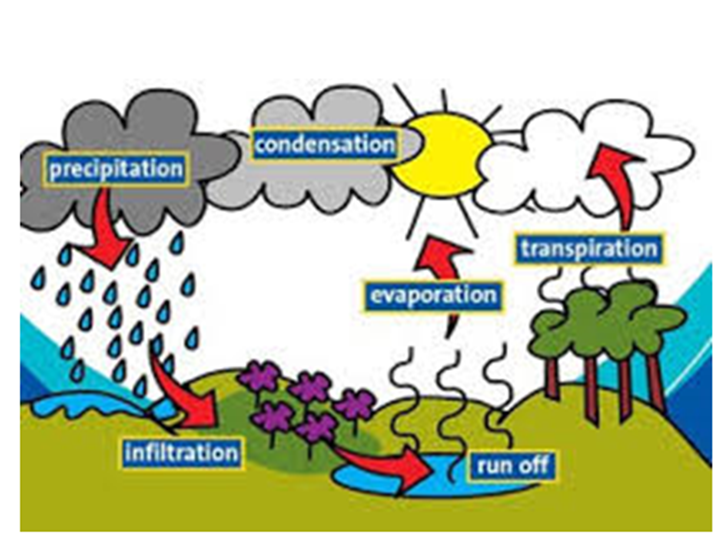
The whole process in which water evaporates and falls on the land as rain and later flows back into the sea via rivers is known as the water-cycle.
The water cycle in nature is also known as hydrological cycle. The various steps involved in the water cycle in the biosphere are:
1. Evaporation:
Evaporation is when the sun heats up water in seas and oceans and turns it into water vapour or steam.
• The Sun’s heat provides energy to evaporate water from the Earth’s surface (oceans, lakes, etc.) and form water vapour which being lighter than air rises up and goes into the atmosphere.
2. Transpiration -The plants continuously absorb water from the soil through their roots.
• Some of this water is utilized by the plants for photosynthesis.
• The excess water in the body of plants is added to the atmosphere in the form of water vapour from the leaves of plants through the process of transpiration.
• The water vapours produced also goes into the atmosphere.
• Transpiration is the process by which plants and trees lose water out of their leaves into the air.
3. During the process of respiration in living plants and during the decay of dead plants water vapour is produced which also goes into the atmosphere.
4. Condensation– As the water vapour rises up, it gets cooled and it eventually condenses back into tiny droplets of liquid water.
5. These droplets are small enough to float in the air and eventually collect together to make a cloud. These clouds can be blown by the wind to move water to different parts of the earth.
6. Precipitation-As more and more water droplets form, they will join together to form bigger water drops in the clouds.
• These drops become too heavy to stay in the air and will fall to the earth as rain.
• In case of extremely cold weather, the water might freeze and fall as hail or snow.
• Any water that falls from the sky-rain, snow, sleet or hail is called precipitation.
7. Percolation and absorption: Some of the precipitation soaks into the ground.
• Some of the underground water percolates through the rock or clay layers to reach the underground water.
• This is called groundwater.
• On land the water is used by the plants, crops and trees to grow. But most of the water flows downhill as runoff (above ground or underground), eventually returning to the seas as slightly salty water.
• In this way water was taken from the earth, returns to the earth and the water cycle is completed.
NITROGEN CYCLE:
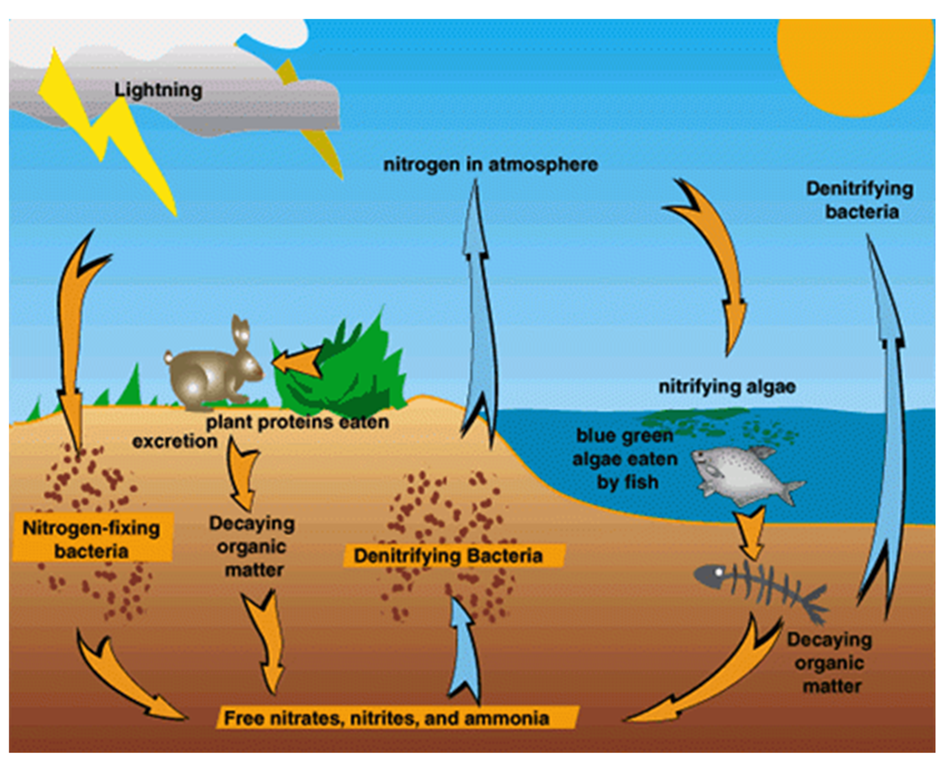
• Nitrogen makes up seventy-eight percent of the atmosphere, but most organisms cannot use this form of nitrogen, and must have the fixed form.
• Nitrogen is also a part of many molecules essential to life like proteins, nucleic acids (DNA and RNA) and some vitamins.
• Nitrogen is found in other biologically important compounds such as alkaloids and urea too.
• Nitrogen is thus an essential nutrient for all life-forms and life would be simple if all these life-forms could use the atmospheric nitrogen directly.
• The nitrogen cycle produces the fixed form of nitrogen these organisms need.
Step 1-
Nitrogen Fixation–
By lightning– During lightning, the high temperatures and pressures created in the air convert nitrogen into oxides of nitrogen.
• These oxides dissolve in water to give nitric and nitrous acids and fall on land along with rain. These are then utilised by various lifeforms.
By bacteria– Molecular nitrogen is converted into nitrates and nitrites by free living bacteria or the bacteria like Rhizobium present in the root nodules of legumes.
• Special bacteria convert the nitrogen gas (N2) to ammonia (NH3) which the plants can use.
Step 2-
Nitrification– Nitrification is the process which converts the ammonia into nitrite ions and then into nitrates which the plants can take in as nutrients.
• Special kinds of bacteria are involved in this process which occurs naturally in the environment.
• The bacteria nitrosomonas and nitrococcus convert the ammonia into nitrite and then nitrobacter convert the nitrites into nitrates by oxidizing NO2 to NO3.
• All these bacteria reside in soil and are called as nitrifying bacteria.
• These soluble nitrates dissolve in soil water and are absorbed by the roots of plants.
• The nitrates and nitrites are used by plants to make amino acids which are then used to make plant proteins.
• The plant may be eaten by an animal, and its biomass used to produce animal protein.
Step 3-
Ammonification– When an animal or plant dies they release wastes from their bodies, nitrogen is released in the organic form.
• This organic nitrogen is converted into ammonium by fungi and bacteria through the process Ammonification.
• After all of the living organisms have used the nitrogen, decomposer bacteria convert the nitrogen-rich waste compounds into simpler ones.
• Urea and egested material is broken down by decomposers.
• This results in nitrogen being returned to the soil as ammonia.
• Decomposers also break down the bodies of dead organisms resulting in nitrogen being returned to the soil as ammonia.
Step 4-
Denitrification- Denitrification is the final step in which the simple nitrogen compounds are converted back into nitrogen gas (N2), which is then released back into the atmosphere to begin the cycle again.
• When the ammonia is converted back into inert nitrogen, the process is called as denitrification.
• Bacteria are involved in this process which takes place in anaerobic conditions.
• Places like deep soils and deep water are the places without oxygen.
• Pseudomonas and Clostridium are responsible for the step of denitrification.
• These bacteria can also live in the places where there is availability of oxygen.
CARBON CYCLE:
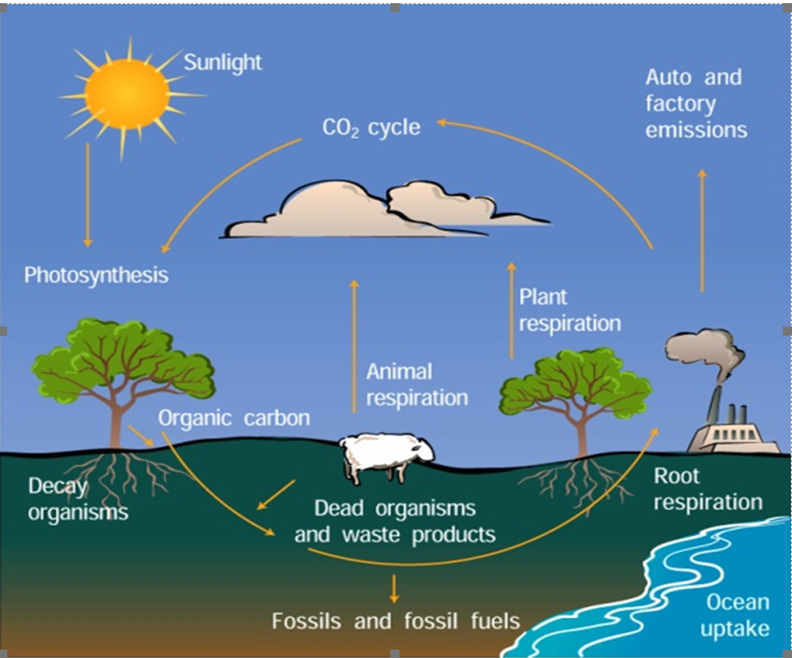
• Carbon is found in various forms on the Earth.
• It occurs in the elemental form as diamonds and graphite.
• In the combined state, it is found as carbon dioxide in the atmosphere, as carbonate and hydrogen carbonate salts in various minerals, while all life-forms are based on carbon-containing molecules like proteins, carbohydrates, fats, nitrogen-cycle in nature nucleic acids and vitamins.
• The endoskeletons and exoskeletons of various animals are also formed from carbonate salts.
The carbon cycle is the process by which carbon moves from the atmosphere into the Earth and its organisms and then back again.
Carbon enters the atmosphere as carbon dioxide from respiration (breathing) and combustion (burning)
Photosynthesis
• Carbon is incorporated into life-forms through the basic process of photosynthesis which is performed in the presence of Sunlight by all life-forms that contain chlorophyll.
• This process converts carbon dioxide from the atmosphere or dissolved in water into glucose molecules.
• Plants store and use this sugar to grow and to reproduce.
• Thus, plants help to remove carbon from the atmosphere.
• When plants are eaten by animals, their carbon is passed on to those animals.
• Since animals cannot make their own food, they must get their carbon either directly by eating plants or indirectly by eating animals that have eaten plants.
At the same time that some processes of nature are removing carbon from the air, other processes are adding more carbon to the air.
Respiration: Respiration is the next step in the cycle, and it occurs in plants, animals, and even decomposers.
• When plants and animals respire, glucose stored in the plants and animals are broken down to release CO2, water and energy.
• Through this process, CO2 is released back into the atmosphere.
Decomposition: As plants and animals die and decay or decompose (or when animals defecate and their waste materials decompose), the carbon found in them are released to the environment.
• When the decaying matter bodies get buried under the ground and are subjected to high pressures and other physical and chemical changes for millions of years, they change into fossil fuels.
Combustion: When the fossil fuels are burnt to provide energy for various needs like heating, cooking, transportation and industrial processes most of the carbon rapidly enters the atmosphere as carbon dioxide gas.
• In fact, the percentage of carbon dioxide in the atmosphere is said to have doubled since the industrial revolution when human beings started burning fossil fuels on a very large scale.
Movement of carbon from the atmosphere to the oceans: The oceans, and other water bodies, soak up about a quarter of the carbon dioxide gas from the atmosphere.
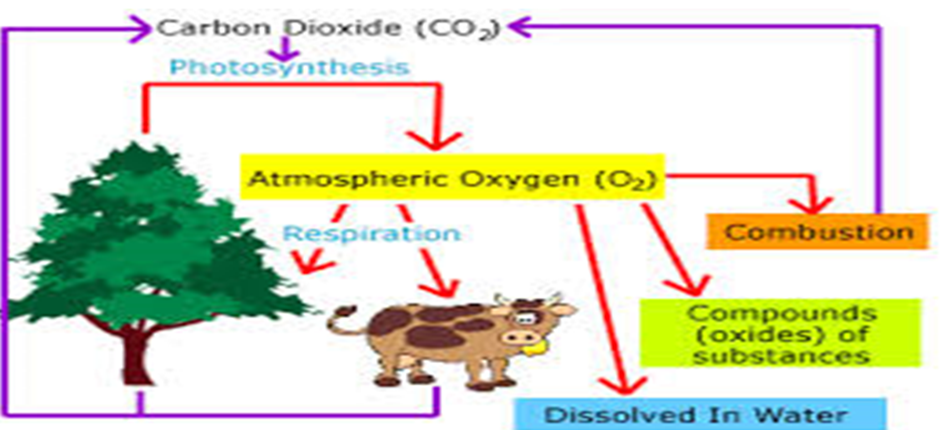
• However, this uptake process is slow.
• Similarly, under normal conditions, the release of carbon dioxide back into the atmosphere from the ocean is also at a very low rate.
Through these steps the total amount of carbon in the environment remains constant. There is no formation or demolition of carbon in this process and it only involves the movement of this element from one form to another.
OXYGEN CYCLE:
• Oxygen is an important element to life on Earth.
• It is the most common element of the human body.
• It makes up about 65% of the mass of the human body.
• Most of this is in the form of water (H2O).
• Oxygen also makes up about 30% of the Earth and 20% of the atmosphere.
The Oxygen Cycle
Oxygen is constantly being used and created by different processes on planet Earth. All of these processes together make up the oxygen cycle. The oxygen cycle is interconnected with the carbon cycle.
Processes That Use Oxygen
- Respiration:
Animals take in simple sugars (glucose) and oxygen and release carbon dioxide, water and energy.
• Decomposition: Is a minor part of the Carbon/Oxygen cycle
Decomposition is when any organic matter (plants, animals) breaks down chemically into all the simple elements that they are made of and these elements return back to the environment.
As plants and animals die and decay or decompose (or when animals defecate and their waste materials decompose), the carbon, oxygen, nitrogen, water, calcium etc. return to the soil and air during decomposition.
Processes That Produce Oxygen
- Photosynthesis:
Green plants/trees take in Carbon Dioxide and water using the chlorophyll in their leaves and energy from the sun they release Oxygen, sugar and water vapor.
• Sunlight – Some oxygen is produced when sunlight reacts with water vapor in the atmosphere.

 Vaishnav Publication
Vaishnav Publication
